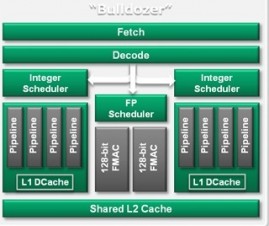Long awaited and often delayed, AMD’s next generation server CPU is a case study in failed communication, not failed technology.
By Alex Herrera
 Amidst all the bullish future-talk at the AMD Financial Analyst Day in February, the company did take out the rear-view mirror occasionally to review the previous year’s accomplishments and also to assess its shortfalls. Among the latter, not surprisingly, were Bulldozer and the company’s associated, lackluster performance in servers.
Amidst all the bullish future-talk at the AMD Financial Analyst Day in February, the company did take out the rear-view mirror occasionally to review the previous year’s accomplishments and also to assess its shortfalls. Among the latter, not surprisingly, were Bulldozer and the company’s associated, lackluster performance in servers.
Long-awaited and often delayed, Bulldozer now carries the stigma of failure. As the next major torchbearer of the Opteron brand, Bulldozer’s frequent slips certainly should take some of the blame for AMD’s lost ground in servers. But more than just being criticized for a lack of timeliness, the perception of Bulldozer is one of a failure in technology, a generally unfair assessment. Rather, the reason many observers are quick to dismiss Bulldozer’s technical merits is more because the company did a poor job of setting reasonable expectations.
Bulldozer was handicapped from the start, as any new CPU generation is going to have a tough time filling the big shoes of AMD’s Sledgehammer, the revolutionary processor (and architecture) from 2003 that gave AMD a substantial, competitive edge over behemoth rival Intel. Sledgehammer proved to be an all-around coup for AMD, but to expect successors to ever achieve that kind of leap-frogging market performance is wishful thinking. Still, in retrospect, had AMD more clearly set expectations for Bulldozer, it wouldn’t be perceived as nearly the dud many are now convinced it is.
Wrong expectations
No doubt, Bulldozer was far later than it should have been, and I certainly don’t think it is nearly the device AMD wanted it to be. But still, I see it more as a failure in communication than in technology. The expectations for Bulldozer were set all wrong. The pervasive expectation among the industry—analysts, OEMs, and customers alike—were high for what Bulldozer would do for AMD’s prospects, specifically in its never-ending battle with Intel.

Part of that was simply because the CPU kept slipping, naturally ratcheting up anticipation each time the date pushed back. And as Intel executed admirably over the same time period—in microarchitecture, implementation and fabrication—AMD fans had to continually turn up the rhetoric. “Oh yeah, just wait until Bulldozer” was the clear sentiment among company proponents, whether it was articulated as such or not. Had AMD attempted to rein in the bluster, Bulldozer would have benefited from some better greased skids when it did finally arrive.
Back then, I never heard AMD saying what it should have, which is precisely what it is finally saying now: that the company clearly optimized Bulldozer for server-type workloads, not high-performance clients, so don’t expect it to be the killer high-performance gaming platform. AMD should have at least intimated as much two years ago. After all, to even a casually keen observer, it certainly looked like that was the direction the part was headed. Once I got to see the first real look under Bulldozer’s hood, I had the same impression of the part as I did when first surveying Sun’s Niagara more than five years ago.
The impression? Clearly, this design was a conscious departure from previous generations, slanted toward multi-threaded, multi-transaction, integer-critical workloads. And conversely, it slanted a bit away from high-performance desktops. Designing dual integer cores that shared one floating-point core per “module” was one dead giveaway. Such a choice freed up die area that could be allocated to more cores, up to 16 in the largest Opteron configuration.
With multi-threaded software still hustling to catch up with the pace of multi-core hardware, clients are having a tough enough time making good use of eight or even four cores for common workloads. So making design tradeoffs to get 16 clearly isn’t something being done for the desk, but rather the datacenter, which can far more easily scale throughput by core count. This does not mean Bulldozer cannot support a capable client platform, but a look at the device clearly painted the picture that AMD was more focused on server prowess than anything else.
But without the right expectations, the first thing most press and industry analysts did when receiving Bulldozer samples was run client-centric benchmarks. Many of those benchmarks are hard-core games, the perfect example of a high-performance, floating-point intensive client workload, and not at all typical of a server workload. Not surprisingly, the results were poor, and accordingly, the product was panned.
AMD now reports demand for Bulldozer on the server side is growing. We don’t doubt it, though there are reasons for the growth largely independent of the product’s merits. Coming from its distant minority share, AMD always gets the benefit of OEMs desires to find a second source. No one wants to be beholden to just one supplier, and they are always going to look kindly on the wares from any vendor that gives them more choices.
But more than that, customers, ISVs and OEMs are now quite likely—after looking past the cloud of negativity—seeing Bulldozer’s merits for server applications. And it is not just OEMs, as InfoWorld bestowed on it 2012’s award for Technology of the Year. One reason is AMD’s claimed 71% boost in database transaction processing, something that comes directly from having all those extra cores. And we can certainly imagine it performs well running virtualization hypervisors in support of cloud computing, as well.
All things considered, we doubt the final incarnation of Bulldozer is quite what AMD wanted to achieve, be it targeted primarily for servers or not. The simple fact it slipped so many times is evidence of that. But its story is also great evidence of how important effective market communication can be, not just at launch, but also in the quarters and years leading up to launch. Because if AMD could have said back then what it is saying now, the market and its observers would have been far kinder to Bulldozer. And the company would have saved itself some serious grief.
Alex Herrera is a senior analyst for Jon Peddie Research.





